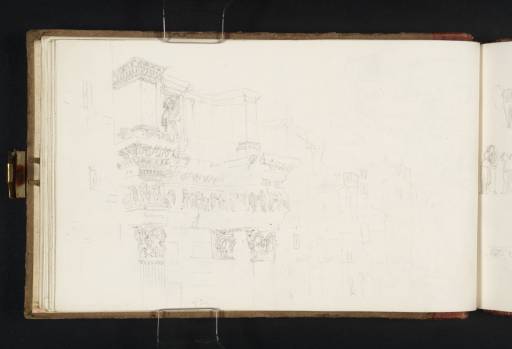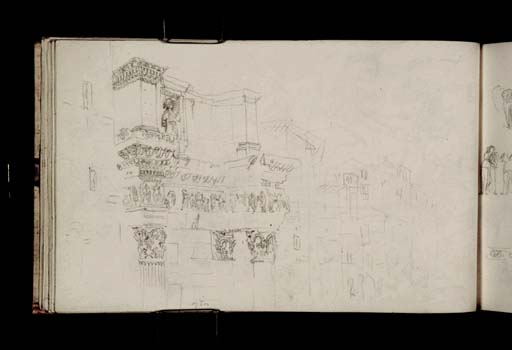Joseph Mallord William Turner The Colonnacce, Rome 1819
Image 1 of 2
Joseph Mallord William Turner,
The Colonnacce, Rome
1819
Joseph Mallord William Turner 1775–1851
Folio 15 Verso:
The Colonnacce, Rome 1819
D16186
Turner Bequest CLXXXVIII 15 a
Turner Bequest CLXXXVIII 15 a
Pencil on white wove paper, 114 x 189 mm
Accepted by the nation as part of the Turner Bequest 1856
References
1909
A.J. Finberg, A Complete Inventory of the Drawings of the Turner Bequest, London 1909, vol.I, p.558, as ‘The Colonnacce (remains of the external walls of the Temple of Mars Ultor); formerly called remains of Temple of Pallas.)’.
1984
Cecilia Powell, ‘Turner on Classic Ground: His Visits to Central and Southern Italy and Related Paintings and Drawings’, unpublished Ph.D thesis, Courtauld Institute of Art, University of London 1984, pp.129, 138, 476 note 10, reproduced fig.79, as ‘The Colonnacce and their decoration’.
1987
Cecilia Powell, Turner in the South: Rome, Naples, Florence, New Haven and London 1987, pp.51 note 8, 57 note 29.
This surviving pair of columns is one of several which once stood in the Forum of Nerva, an area also known as the Forum Transitorium, adjacent to the Forum of Augustus, see folio 14 verso (D16184). With the entablature and attic above, the columns, known as ‘Le Colonnacce’ (Broken Columns), form a portico at the east end of the Forum, highly decorated with bas-relief sculptures. Formerly known as the Temple of Pallas, or the Temple of Minerva owing to the large relief of the goddess Minerva found in the attic space between the columns.
As Cecilia Powell has discussed, the columns and entablature were greatly admired during the nineteenth century.1 Charlotte Eaton, for example, who visited Italy just before Turner, described the monument in Rome in the Nineteenth Century:
This building consists of two marble Corinthian columns in front of this wall, more than half buried beneath the pavement, supporting a frieze richly sculpted with figures emblematical of the arts of Pallas; and in the centre of the perfect and highly ornamental entablature stands the relievo of the goddess herself ... Whatever the building may be, the sculpture of the frieze, the whole entablature and the columns, are beautiful. They are perhaps too beautiful, or at least too beautified; and in a style rather too florid for true taste; but the ornaments are strictly correct and appropriate; the only fault is they are in excess.2
The angle of Turner’s viewpoint is similar to that in Piranesi’s etching ‘Veduta di altri avanzi del predetto Foro di Nerva detti le Colonnacce’, a plate from volume I of Le antichità Romane, first published 1756.3
Nicola Moorby
September 2008
How to cite
Nicola Moorby, ‘The Colonnacce, Rome 1819 by Joseph Mallord William Turner’, catalogue entry, September 2008, in David Blayney Brown (ed.), J.M.W. Turner: Sketchbooks, Drawings and Watercolours, Tate Research Publication, December 2012, https://www


